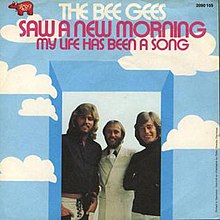Saw a New Morning
| "Saw a New Morning" | ||||
|---|---|---|---|---|
 | ||||
| Single by Bee Gees | ||||
| from the album Life in a Tin Can | ||||
| B-side | "My Life Has Been A Song" | |||
| Released | March 1973 | |||
| Recorded | September 1972 The Record Plant, Los Angeles | |||
| Genre | Symphonic pop | |||
| Length | 4:13 | |||
| Label | RSO | |||
| Songwriter(s) | Barry, Robin & Maurice Gibb | |||
| Producer(s) | Barry Gibb, Robin Gibb, Maurice Gibb | |||
| Bee Gees singles chronology | ||||
| ||||
| Audio sample | ||||
"Saw a New Morning" | ||||
"Saw a New Morning" is the 1973 single released by the Bee Gees. It was also the group's first single released on Robert Stigwood's newly created records label RSO Records. The Bee Gees moved to Los Angeles in 1972 to record the album Life in a Tin Can which was a new direction for the group, who had been recording in England since 1967. The B-side, "My Life Has Been a Song" features lead vocal by Robin Gibb as well as Barry Gibb.[1]
Composition and recording
This song contains melodic ideas that the group would revisit on the later track "Edge of the Universe". Written in 1972 and recorded around September the same year. On the song, Maurice Gibb played the bass part through electric piano with Jim Keltner's drums providing a thump. While backing guitarist Alan Kendall plays guitar with Barry and Maurice Gibb.[2]
Reception
This single was the first and only single from the album, the single did not fare well and stalled at #94 in the US,[3] while it did not chart at all in the UK.[4] Ironically, while the single flopped in most of the world, it reached #1 in Hong Kong, as did their next single "Wouldn't I Be Someone", which also flopped in both the US and UK.
In April 1973, they performed the song on The Midnight Special and The Tonight Show Starring Johnny Carson, in addition to a 1973 TV special called Love Sounds Special in Japan.[5]
Billboard commented on the Bee Gees "distinct vocal blend" and the backing instrumentation that "sounds like a symphonic orchestra."[6] Cash Box said that "the accent is on melody and three part harmony as Robin, Barry & Maurice prove that they're still one of the finest vocal groups around."[7]
Personnel
- Barry Gibb — lead, harmony and backing vocals, acoustic guitar
- Robin Gibb — lead, harmony and backing vocals
- Maurice Gibb — harmony and backing vocals, bass acoustic guitar
- Alan Kendall — acoustic guitar
- Jim Keltner — drums
- Johnny Pate — orchestral arrangement
Charts
Weekly charts
|
Year-end charts
|
References
- ^ "The Bee Gees - Saw a New Morning / My Life Has Been a Song". 45cat. Retrieved 4 February 2015.
- ^ Brennan, Joseph. "Gibb Songs: 1972". Retrieved 4 February 2015.
- ^ Dafydd Rees, Luke Crampton (1999). Rock Stars Encyclopedia. ISBN 9780789446138. Retrieved 4 January 2015.
- ^ Barry Lazell (April 1989). Rock movers & shakers. ISBN 9780823076086. Retrieved 4 January 2015.
- ^ "Bee Gees - Saw A New Morning - Live". You Tube. Retrieved 4 January 2015.[dead YouTube link]
- ^ "Radio Action & Pick Singles" (PDF). Billboard. March 3, 1973. p. 102. Retrieved 2020-07-29.
- ^ "CashBox Record Reviews" (PDF). Cash Box. March 3, 1973. p. 16. Retrieved 2021-12-11.
- ^ "Go-Set Australian charts". poparchives.com. August 4, 1973. Retrieved 4 February 2015.
- ^ Kent, David (1993). Australian Chart Book 1970–1992. Australian Chart Book, St Ives, N.S.W. ISBN 0-646-11917-6.
{{cite book}}:|format=requires|url=(help) - ^ a b "Songs Written by the Gibb Family on the International Charts - Part 2" (PDF). brothersgibb.org. Retrieved 4 February 2015.
- ^ "Billboard Hits of the World". Billboard: 60. July 14, 1973. Retrieved 4 February 2015.
- ^ "Classifiche". Musica e Dischi (in Italian). Retrieved 28 May 2022. Set "Tipo" on "Singoli". Then, in the "Artista" field, search "Bee Gees".
- ^ "Billboard Hot 100 Charts". Billboard: 72. April 7, 1973. Retrieved 4 February 2015.
- ^ "Cashbox Top 100". Cashbox Archives. April 7, 1973. Archived from the original on 4 March 2016. Retrieved 4 February 2015.
- ^ "Billboard Hits of the World". Billboard: 47. August 18, 1973. Retrieved 4 February 2015.
